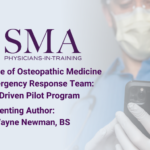Abstract | May 4, 2021
Arkansas College of Osteopathic Medicine Simulated Emergency Response Team: A Student Driven Pilot Program
Learning Objectives
- Compare and contrast patient scenarios students encounter in the simulation-based learning included in school curriculum versus the complex patient scenarios encountered on emergency medicine clinical rotations;
- Describe how the Arkansas College of Osteopathic Medicine Emergency Response Team can help better prepare students for emergency medicine clinical rotations;
- Discuss perceived benefit of the Arkansas College of Osteopathic Medicine Emergency Response Team, as reported by participants.
Background:
Despite the rigors of pre-clinical medical education, medical students are often ill prepared for what they encounter during clinical rotations. The integration of simulation-based learning into medical curriculums affords students a hands-on opportunity to make the connection between their classroom education and their clinical skills in preparation for clinical rotations. However, it is constrained to the course material being covered and is often omnidirectional in diagnosis and simplistic in treatment. While this method certainly gives the beginning learner an overview of how the most common illnesses may present, it often fails to capture the complex, critically ill patients encountered during Emergency Medicine (EM) rotations.
Goals:
This student-driven pilot program was designed to provide a more realistic and robust simulation experience beyond the scope of the standard curriculum for student volunteers interested in Emergency Medicine. Our goal was to investigate if the program could better prepare students for their future EM rotations.
Methods:
Students participated in two critical care simulations, and completed a 5-point Likert Scale Survey to asses the perceived benefit of the program before and after each simulation.
Results:
Ten student volunteers participated, three first year and seven second year osteopathic medical students from The Arkansas College of Osteopathic Medicine. 100% of participants felt this program would increase awareness of the members of a healthcare team. 80% felt this program would increase their ability to adapt to an unknown clinical scenario. 90% felt it would increase their ability to treat a patient in a clinical setting and increase in their environmental awareness of an Emergency Department. 100% felt the program increased their ability to apply information learned in the school curriculum and 90% felt it would increase retention of learned
curriculum. 100% of participants felt a program like this should be added to the curriculum.
Discussion:
Our results suggest the majority of participants felt this program would increase their preparedness for EM rotations. Responses also showed that students felt this program would increase their ability to apply and retain information learned within the school curriculum. These results are consistent with the current consensus regarding the use of simulation-based learning to improve clinical performance. Limitations include small sample size due to logistical difficulties with class scheduling and the COVID-19 pandemic; self-report bias should also be considered. Further implementation of this program will need to take closer consideration of scheduling to increase sample size.

